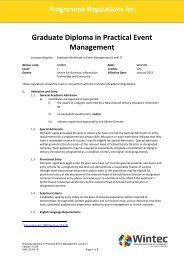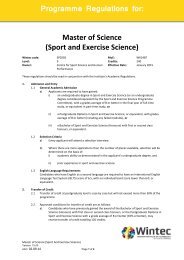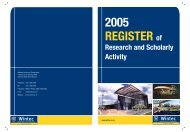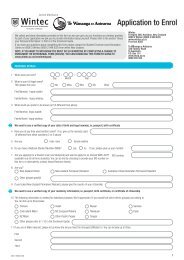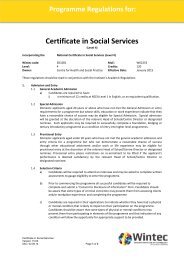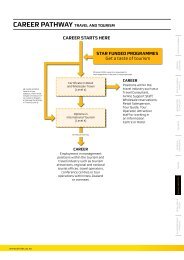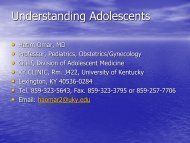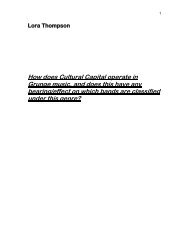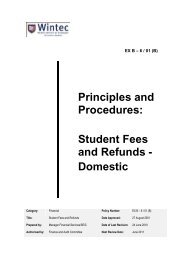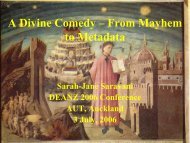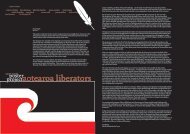PDF (He Manawa Whenua Indigenous Conference Historical ...
PDF (He Manawa Whenua Indigenous Conference Historical ...
PDF (He Manawa Whenua Indigenous Conference Historical ...
You also want an ePaper? Increase the reach of your titles
YUMPU automatically turns print PDFs into web optimized ePapers that Google loves.
• Ngarimu & 28 th Māori Battalion DoctoralScholarship• Te Atawhai o Te Ao Doctoral Scholarship• Tainui waka Doctoral Scholarship
Walters (2011) defines those as an event or setof events perpetuated on a group of people(including their environment) who share aspecific group identity (e.g., nationality, tribalaffiliation, ethnicity, religious affiliation) withgenocidal or ethnocidal intent (i.e.,annihilation or disruption to traditional lifeways, culture and identity) (Walters et al.,2011). Such events include direct attacks onthe community, as in the case of massacres, aswell as indirect attacks, as in the case ofdestroying buffalo to near extinction.
GovernorSovereigntyRights of British peopleCustomary Native titleTangata<strong>Whenua</strong>WorldviewSharedSpaceTangata TiritiWorldviewTe Tiriti O Waitangi 1840 –foundation:<strong>He</strong> Whakaputanga 1835Trade & technologyLand & resourcesLands designated forMaoriCustoms, beliefs, culture
Treaty of Waitangi violations Legislative - Critical AnalysisBreaching TOW – To confiscate Land & resourcesConsequences of Breaching TOW for Tangata <strong>Whenua</strong>‣Native lands Act 1862 designed to break downcommunal ownership.‣Native reserves Act 1864: All remaining reserve landput under settler control of the Crown.Breaching TOW - By Blocking all forms of redress & accountabilityfor fraudulent actionsLegislation used to acquire land and resourcesConsequences of Breaching TOW for Tangata <strong>Whenua</strong> –Suppression of Rebellion Act 1863• No right to trial before imprisonment. Its intentionwas to punish certain tribes for perceptions ofrebelling against the Crown.• Legislation used to block all avenues of redress orcompensation by arresting any Māori whoprotested.Breaching TOW – Using legislation to Assimilate & subjugateMāori culture / language & identity.Consequences of Breaching TOW for Tangata <strong>Whenua</strong>The Native Schools Act: 1867• Schools would assist in the process of assimilation. 1871• A Government stipulation that instruction in NativeSchools had to be in• Tohunga Suppression Act: 1908• Penalties were imposed on tohunga (experts in Maorimedicine and Maori spirituality).• Legislation used to assimilate language, culture &identity
• Stole land & resources• Removed traditional teachings,tikanga & protocols• Subjecting Tangata <strong>Whenua</strong> tobecoming paupers on their landin direct violation of Te Tiriti1840• Loss of traditional principles,values & protocols• Near extinction of Māorilanguage• Marginalization of culturalknowledge & cultural identity
• Formed in 1837 in London England• Its role, to figure out how to civilise (assimilate) and Christianize<strong>Indigenous</strong> cultures -• It distributed assimilating policies to settler governments inAustralia, Canada and New Zealand• They decided the best way to indoctrinate the next generation wasby assimilating the children... (Armitage, 1995, p.1).
PersonalcontextInstitutionalcontextSocietalcontext<strong>Historical</strong>context.
Contextual historical intergenerational trauma in genealogyGeneration 41840 - 1940Relationship withthe ColonialsGeneration 3Great Grandfather:Te Nahu Te Kuri Waretini-Weteni.Grand Father:‣Fought in the Waikato invasion against the Britishempire1863‣Exiled with King Tawhiao into the King country.‣Fought along side Rewi Maniapoto and Tuhoe atOrakau PaBrought up by Princess Te PueaLegislative Violations:‣Native Lands Act‣Suppression of Rebellion Act1863‣Waikato Invasion‣Native Schools act‣Tohunga suppression ActLegislative violations:1920’s-1989Aftermath ofcolonialassimilationKapa (Tom) Te WharuaWaretini Weteni‣<strong>He</strong>lped build Turangawaewae Marae‣Spoke Maori but was caned and punished inschool.‣Fought in World War Two‣Moved away from Māori culture for westernreligion‣Native Schools Act 1867‣Tohunga Suppression Act 1908‣Native <strong>He</strong>alth Act 1909‣WW2‣Hunn Report 1961Generation 21946 – 1996Once wereWarriorsgenerationFather:Raymond BartholomewWaretini KarenaWelder-Boilermaker‣Under valued anything Maori‣Didn’t learn tikanga‣Put his friends before his family‣Beat and abused his wife and children‣Was not taught any principles so did not instillvalues or ethics into his childrenLegislative Violations:‣Hunn Report 1961‣Pepper potting system‣Rural to Urban migrationGeneration 1Mokopuna:Grew up with no identityLegislative Violations:Rediscoveringcultural heritageRawiri-David-Waretini-Junior :KarenaMusician - Lecturer:‣Did not know my native language or culture.‣Brought up by the state from five years old‣Decided to change the cycle‣Chased an education‣Went to rediscover my cultural heritage‣Pu Ao Te Atatu‣NZ Constitution Act 1986‣Fore shore & Seabed 2004‣Takutai Moana Bill 2010‣Oil drilling‣Fracking‣TPPA
• The native idea ofhistorical traumainvolves theunderstanding thatthe traumaoccurred in thespirit or soul… (Duran, E, 2006,p.7). Rawiri & Dr Eduardo Duran 2012
• “Epigenetic researchhas discovered thatat a cellular level,stress from onegeneration can becarried to the nextgeneration (Walters,K, 2012).Rawiri & Dr Karina Walters
• Violence is a spiritually conscious being, amanifested entity/energy• Oppressors who fire their energy ofviolence at victims perpetuate a spiritualimprint on a victims consciousness(Duran, E, 2012).
Tuakiri o te TangataPoutama:FrameworkPōwhiri PoutamaPūrakau ModelTikangaEthical ValueTe Whare Tapa WhaMāori EthicsEthical PracticeSupport NetworksHauora OrangaOutcomesPreferred story& strategies for wellnessWhakaorangaĀria:TheoryRauemi:ProcessTukanga:StructureKaupapa Māori worldviewGuiding PrinciplesTe Whiuwhiu o te HauMāori counselling sessionWhakatauProtection & safety planWhakapuakiWhakatangitangi/Whakaratarata<strong>He</strong> kākano āhauI ruia mai i Rangiātea 1And I can never be lostI am a seed, born of greatnessDescended from a line of chiefs,<strong>He</strong> kākano āhau(Karena, R,D,W, 2012)
WhakaotingaWhakaorangaWhakaratarataWhakatangitangiWhakapuakiMihi WhakatauEffective closureTo implement actionplanTo develop actionplan & strategiesTo shed tears/ tobring fourth maemaeEstablish issuesWhakamoemitiEstablish RelationsSpiritual/MentalPreparationsBy Paraire Huata
Age Period Stage Characteristic0 – 15yrs Tiaki(Cared for)The story of development begins with the stories ofothers, who ‘author’ the ‘preface’ and‘introduction’ of a person’s life.15 -25yrs Taraia(Experimentation)The life story experiments with various ‘plots’. Itdepends less and less ‘editing’ by others forprovision.25 – 50yrs Tino Rangatiratanga(Self-determination)The story of development takes on its own lifewhere choices are made about with whom onebecomes a ‘co-author’. Decisions are made aboutthe ‘storyline’ of the following ‘chapters’.50 – 65yrs Arotakenga(Evaluation)The story writes into its history new ‘editions’depending to whom the story is being told. It also isa time of reflection and evaluation65 – death Whanau Whanui(Extended family)Moments in one’s life story are highlighted in a‘biography’, like a ‘movie’ being played in one’smind. Enjoying and depending on family becomessignificantElkington, J.(2001)
0 15 15 2525 5050 65 65 Till deathTiakiTaraiaTinoRangatiratangaArotakengaWhanau whanuiPūrakau Model: = Spaces of time in ones life= The fractured Wairua
=From tapu- or sacredTo noa- or desecration
FacilitatorThree modes of establishing relationsMediatorPerpetratorDeficitpositionVictimLORETeacherConsciousawarenessLearnerCulturalcontextKawaTikanga
• Due to ‘intent,’ spiritual violence has beendelivered upon another leaving a spiritualimprint creating a turbulently poisonousreaction manifesting both internal andexternal consequences (Duran, 2012)
WairuaSpiritHollowMiseryHinengaroThoughtsBroken spiritApprehensionInsignificantDespairFractureUnlovedShameFear of being touchedCan’t communicate with othersTinanaPhysicalNon-trustingHumiliationWhanauEnvironment
• Those who have been imprinted by thespirit of violence tend to show internalindicators such as depression, isolation,low self esteem, suicidal, or externalindicators such as;• acting out in aggression, or perpetuatingviolence upon others (Duran, 2012).
Coloured perceptions due to trauma
• Spiritual problems need spiritual solutions(Duran, 2012).
Iho MatuaIn what way do you connect to others?ManaHow would you describeyour worth as a person?MauriWhat is your understanding ofyour own life essence?WaihangaWhat talents/coping strategieshave you fostered to dealwith the issue?WehiHow would you describe yourselfwhen compared to your peers?TapuWhat does the wordsacred mean to you?IhiTell me a little aboutyour personality?NoaWhat is it that you doto fit in with society?HinengaroHow do you cope in terms of processinginformation when feeling overwhelmed?NgakauEmotionally, how has thisexperience impacted?WhatumanawaWhat is it that you hold most dear to you?PumanawaWhat traits, skills have you geneticallyinherited that have enabled you torespond to the issue?
Gaining anawareness 0fhistoricalcontextsImplement<strong>Indigenous</strong> strategiesthat respond tofuture wellbeingImplement <strong>Indigenous</strong>parameters that protectfuture generationsEncourage <strong>Indigenous</strong>development for thenext generation
Track back to original sourceSet parameters in thefutureHistory---timeline ---futureUnpack issue; examine,explore, analyze impacts &ramifications, identifypreferred story & strategies
Whakamana-+=Noa/ DesecratedWe are a seed, born of greatnessDescended from a line of chiefs,<strong>He</strong> kākano tātouTapu / Sacred
HavinglimitedknowledgeBecomingmore proactivewithindigenousissues516Transformingself, family,community23GainingknowledgeReclaimingindigenousposition4Impact oflearningaboutAncestors
• Incorporate Māori traditional healing approaches into counsellinginterventions• Implement an intergenerational transfer based on a positiveposition at hapu and iwi level• Take charge of our historical, present and future wellbeing.• Link into international <strong>Indigenous</strong> networks to becometransformative across the global <strong>Indigenous</strong> world.
Armitage, A, (1995). Comparing the policy of aboriginal assimilation in Australia,Canada and New Zealand. University of, Vancouver: Canada. UBC Press.ISBN: 0-7748-0458-0Duran, E. (2006). <strong>He</strong>aling the soul wound: Counseling with American Indians andother Native Peoples. New York, NY: Teachers College Press.Stewart, B. (Producer). (2009). Kymatica. [DVD].Retrieved March, 28, 2012from:http://www.youtube.com/watch?v=AanQ2mY2jjc&feature=player_embeddedTreaty Educations for migrant groups. (2006). Tangata Tiriti- Treaty People:An interactive workbook on the Treaty of Waitangi. Auckland: NewZealand. Auckland Workers Educational Association.Walters, K. (2012). Embodiment of historical trauma and micro-aggressiondistress.[Motion picture]. Retrieved March 28 2012 from:http://www.youtube.com/watch?v=WzPNWTD56S8



